Avoid These Common Sautéing Mistakes for Perfect Results
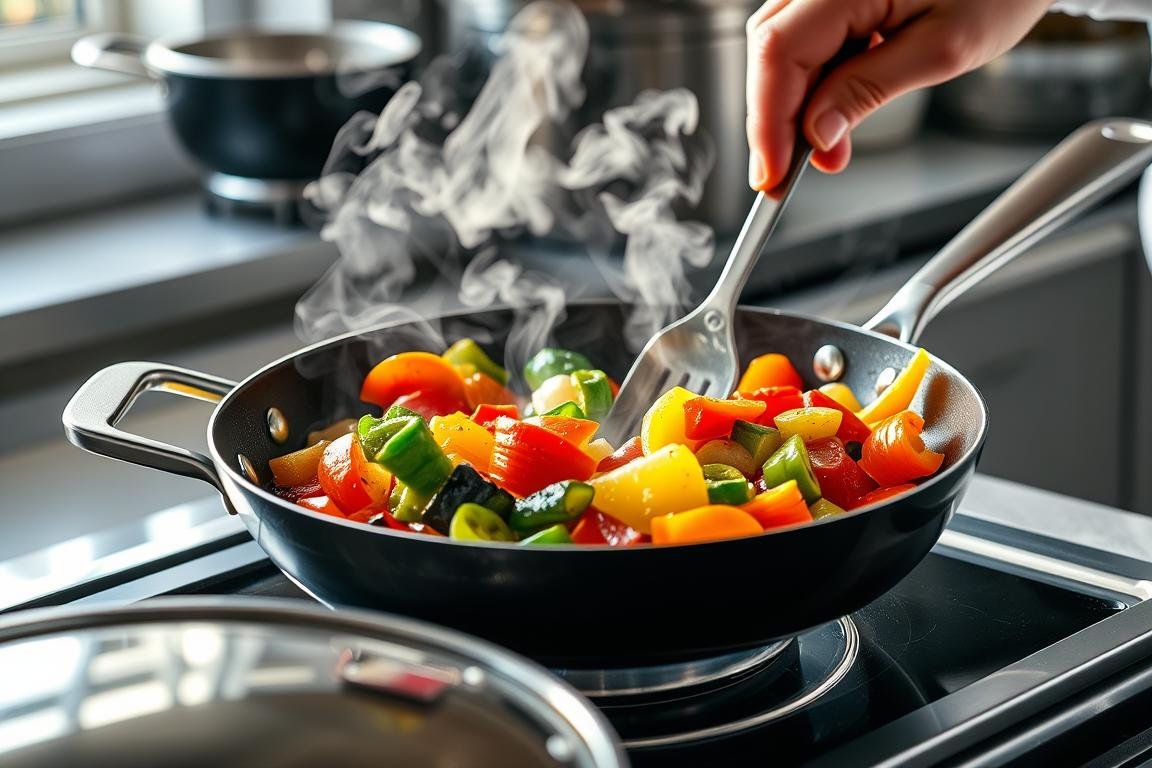
Aspiring chefs and home cooks, it’s time to improve your culinary skills. Master the art of sautéing, a celebrated kitchen hack. Derived from the French word for “jump,” it means flavors blend in a lively dance over high heat. Yet, making simple mistakes can ruin your dish. The difference between perfect and soggy results is small. Sautéing right means crisp veggies and juicy meats. It’s an art that needs precision.
Experts like Jairo Ducos and Christopher Diamond, with advice from Lisa Counts and Stephen Chavez, will guide you. This guide, published on April 22, 2023, at 2:34 pm EST, teaches flawless sautéing techniques. With it, your dishes will taste so good, they seem magical.
Key Takeaways
- Understand the importance of using the right pan for efficient heat distribution.
- Learn the significance of oil temperature, ensuring your pan is preheated to prevent sticking.
- Discover the key to avoiding overcrowded pans for optimal browning.
- Grasp the fundamentals of seasoning to enhance flavor profiles.
- Identify the necessity of consistent stirring for even cooking.
Understanding the Sautéing Technique
If you want to make your cooking better, learn to sauté. This method uses high heat to create tasty meals. Chefs use it to sear food quickly, giving dishes rich flavors and textures. Both home cooks and pros can master this skill.
What is Sautéing?
Sautéing comes from the French word ‘sauter’, which means ‘to jump’. It’s cooking food fast in a bit of oil or fat on high heat. This method browns food while keeping it moist and flavorful. It’s perfect for making veggies crisp and meats tender. Using sautéing, chefs can add deep flavors to dishes quickly.
The Importance of High Heat
For sautéing, you need to cook on high heat. This lets the food’s surface sear, locking in juices. It creates a tasty, caramelized outside. This method keeps ingredients fresh and tasty. It’s great for quick, healthy meals.
Choose the right tools and ingredients for sautéing. A 10-inch stainless steel pan works best because it doesn’t react with foods. Use oils like canola that can handle high heat. But don’t put too much in the pan. Too many items will lower the heat and mess up the cooking.
The size and cut of your ingredients matter a lot. For example, cut onions and garlic the same size for even cooking. This way, onions stay slightly crunchy, and garlic gets lightly browned without getting bitter. Sautéing is more than cooking. It’s about how heat, oil, and food work together.
So, get into sautéing by heating your pan right, controlling the heat, and trying different oils and foods. Your dishes will burst with flavor. Plus, your sautéing skills will show off your cooking smarts.
Mistake 1: Using the Wrong Pan
When you cook, the type of cookware you use matters a lot. Using the correct pan is key for dishes that taste great. Make sure to choose the right pan to get the best results.
If you cook, whether at home or as a chef, pick a pan with a heavy bottom. Stainless steel or cast iron pans are great because they spread heat well. Skillets with sloping sides are good for flipping food and getting moisture out. This way, your food won’t steam when it should be sautéing.
Here are some tips for picking the perfect pan for sautéing:
- Thickness: Choose pans with a thick bottom. They keep and spread heat better, preventing burning.
- Material: Go for stainless steel, cast iron, or non-stick aluminum. They’re good at holding and spreading heat.
- Size: Make sure the pan lets you spread food out. It shouldn’t be too crowded. This is key for sautéing right.
Using these tips can really improve your cooking skills. Getting the right pan is a big deal. It’s the first step to getting better at sautéing and enjoying cooking more.
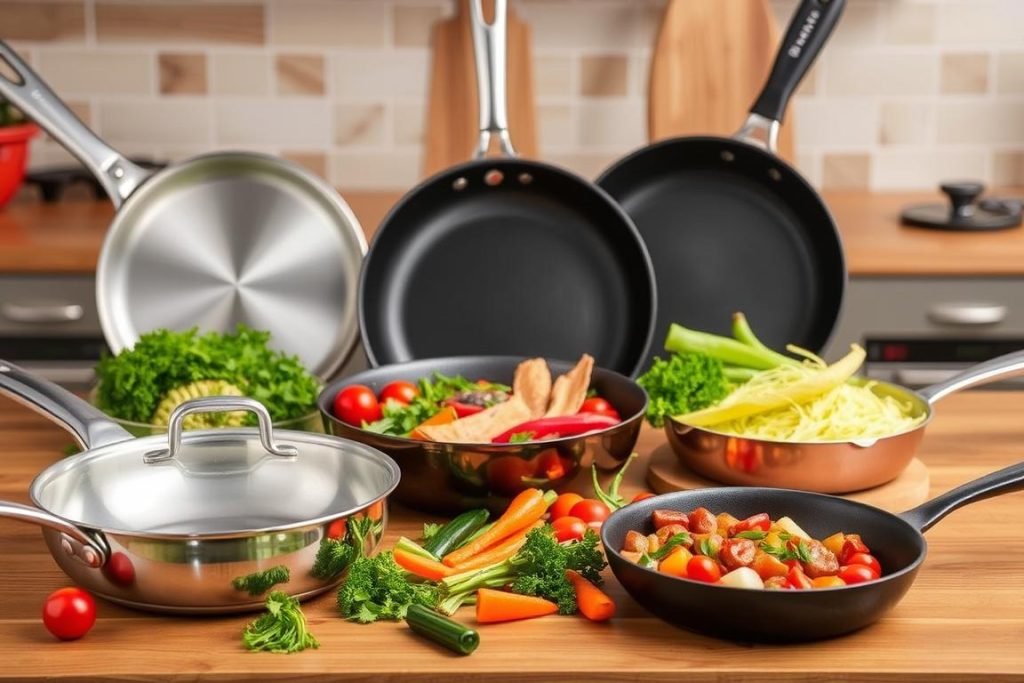
Lastly, use the water droplet test to see if your pan is hot enough. If a drop of water rolls around instead of evaporating, it’s time to add oil. Now, you’re ready to start sautéing perfectly.
2: Skipping the Preheat
Think you can start sautéing the moment your stove turns on? Think again. Preheating your pan is a crucial cooking tip often overlooked. It might seem small, but the success of high-heat cooking and pan searing depends on it.
You’ve prepared your ingredients with care, but then they end up limp in the pan. Without preheating, food steams instead of sears. This can make you wonder if you’re truly sautéing or just stewing your meal in its juices. It’s clear why preheating is key for achieving those perfect, delicious results.

Key Takeaways
- Preheating your pan ensures it’s hot enough for pan searing, which is key for texture and flavor.
- Sautéing is not just cooking; it’s about getting the right crispiness and color on your food.
- Steaming can happen instead of sautéing if the pan isn’t preheated to the right temperature.
- The sizzle sound is your sign that the pan is ready for the ingredients to be cooked perfectly.
- Skipping the preheat might save time, but it will cost the flavor and look of your dish.
Mistake 3: Overcrowding the Pan
When perfecting your sautéing skills, it’s vital not to overcrowd your pan. Overcrowding can change your food’s texture and flavor. For stir-frying, each item must have space to touch the heat directly. This ensures everything cooks evenly and gets browned properly, which is key for flavor.
Why does this matter? Adding too many items at once can drop the pan’s temperature. This creates steam from their moisture, stopping them from getting that golden color. Caramelization isn’t just about cooking; it brings out the best flavors and textures in your dishes.
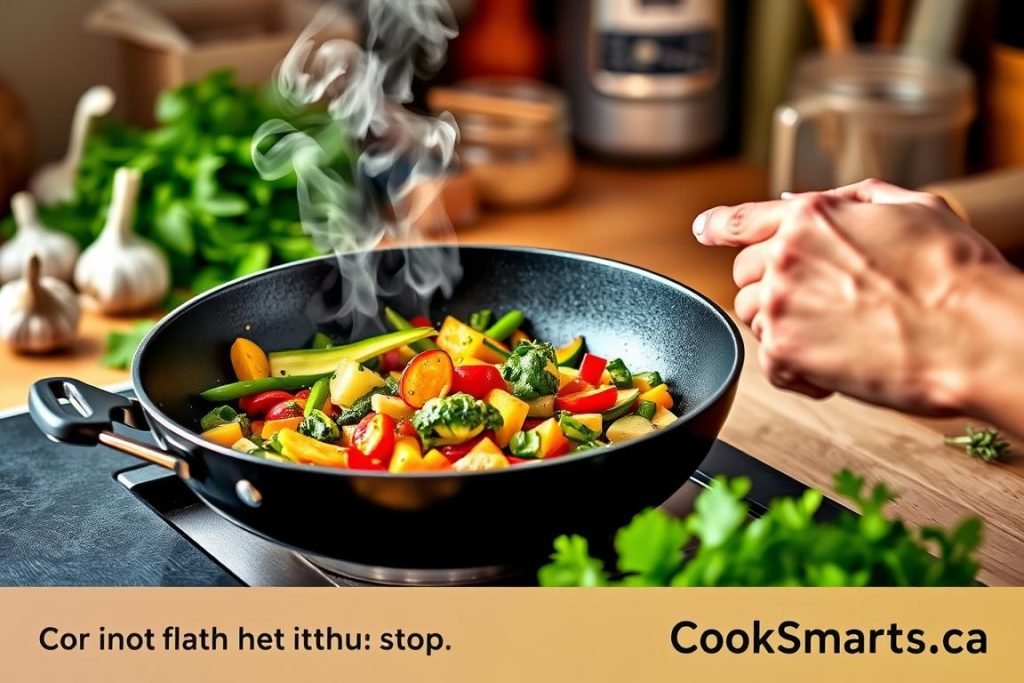
To avoid overcrowding, use a bigger pan or cook in batches. This way, everything has the room it needs to be sautéed right. Better textures and improved tastes are the rewards of giving your ingredients more space. Here are some tips and facts to help you avoid common mistakes and sauté correctly:
| Common Mistake | Impact on Food | Best Practice |
|---|---|---|
| Overcrowding the pan | Uneven cooking, moisture retention | Cook in smaller batches |
| Insufficient preheating | Food sticks, uneven cooking | Preheat pan to the right temperature |
| Uniform ingredient size | Uneven browning and texture | Chop ingredients evenly |
| Incorrect oil amount | Food sticks, poor texture | Use a thin, even layer of high smoke point oil |
| Adding wet ingredients | Sogginess, lack of crispiness | Avoid or thoroughly dry ingredients before adding |
Avoiding overcrowding in your pan is crucial for advanced sautéing and stir-frying. Next time in the kitchen, ensure your ingredients have enough space. Your cooking skills and taste buds will be thankful!
4: Using Insufficient Oil
Have you ever asked yourself why your sautéed dishes lack the depth of flavor of restaurant meals? The secret might lie in the oil you use and how much. Chefs know that using just the right amount of oil is key to flavorful meals. Proper sautéing techniques prevent food from sticking. They also give your favorite dishes a golden, crispy outside.
Using too little oil can seem like a good idea to save calories. But, it often results in food sticking to the pan or getting burnt. Using too much oil, however, might make your dish too greasy. So, how do we find the right balance? It’s all about knowing different oils and their smoke points, your pan’s size, and the food you’re cooking.
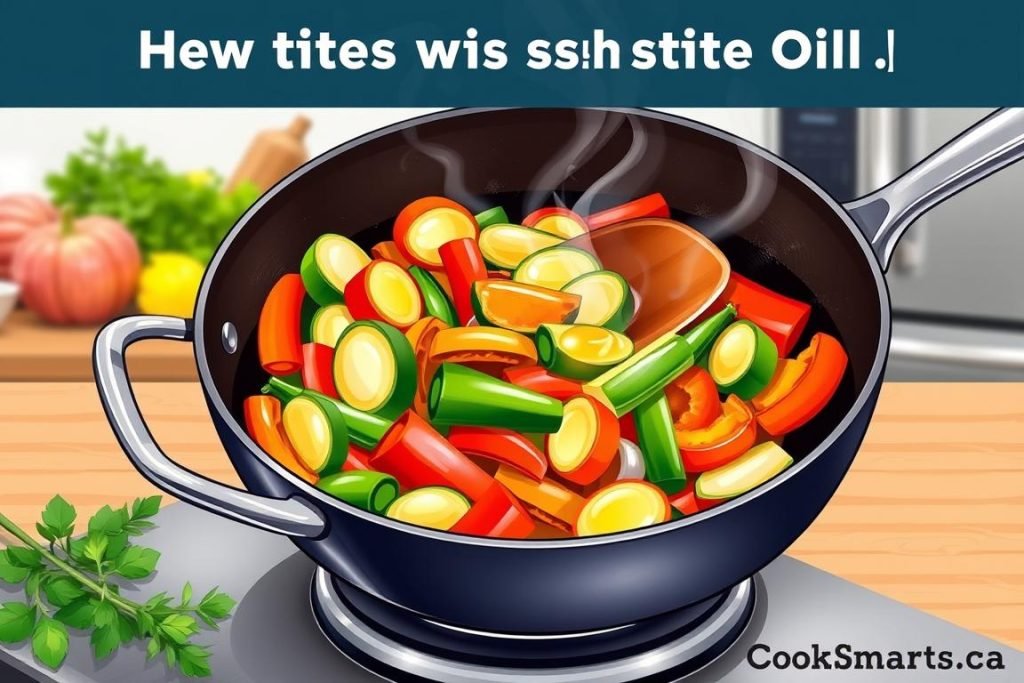
Key Takeaways
- Ideal pan size for successful sautéing is between 10 to 12 inches, ensuring ample room for heat distribution.
- Be mindful of smoke points; canola and peanut oils are your go-to for high heat, while extra-virgin olive oil should be reserved for lower temperatures or flavoring after cooking.
- Understand your fats – using a half butter, half oil mix can infuse your dish with rich flavor while maintaining a higher smoke point.
- Proper preheating is crucial – aim for at least 330°F, and give your pan about 4 minutes to reach the ideal sautéeing temperature.
- Avoid overcrowding the pan to ensure each ingredient makes contact with the heated surface, allowing for even sautéeing rather than steaming.
Mistake 5: Neglecting Seasoning
Mastering culinary skills means making flavorful meals. A key step is seasoning. Without it, even sautéing can fall flat. This step is crucial for those wanting to improve their culinary skills. It turns good dishes into great ones.
Seasoning is more than just salt or pepper. It means adding herbs, spices, and aromatics at the perfect times. These additions boost your dish’s complexity and depth.
Cooking tips suggest seasoning early and adjusting often. Begin with a little salt to bring out natural flavors. Then keep tasting and tweaking. This way, your dish will have a balanced taste.
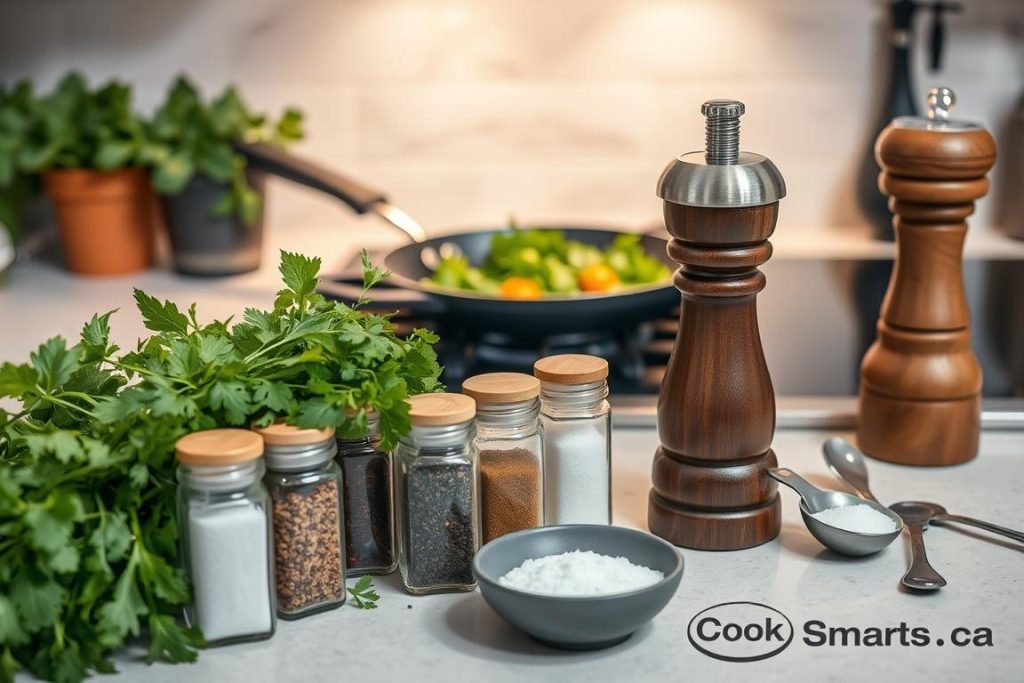
- Taste as you go to adjust the seasoning, ensuring every layer has just the right amount of flavor.
- Remember, if you’re cooking in batches, season each batch to maintain consistency throughout the dish.
- Consider the dish’s overall flavor profile — acidic, sweet, salty, and bitter elements should be in harmony.
Seasoning isn’t just about adding flavors. It’s about unlocking the potential of simple ingredients. It turns them into a cohesive, delightful experience. So, don’t skip seasoning. It’s a simple but important part of your cooking tips to make every dish great.
6: Not Stirring Frequently
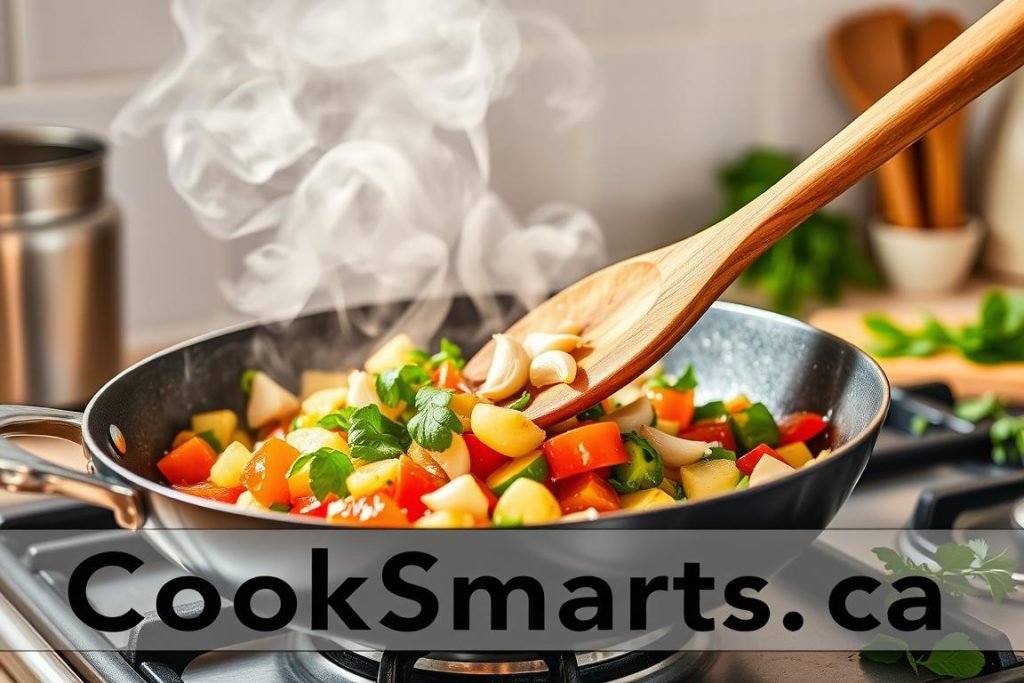
Ever wonder why your home-cooked meals don’t taste like the ones from a restaurant? It might be as simple as how you stir. Sautéing isn’t just throwing ingredients into a pan. Various kitchen tricks and cooking skills can boost your dishes. Mastering the art of stirring is key in sautéing techniques. Let’s see how stirring often can change the taste and feel of your food.
Think of sautéing like a dance, where keeping in motion creates perfection. Like a dancer moves with the music, you should keep your food moving. This prevents it from sticking and ensures it cooks evenly in the high heat needed for a great sauté.
Key Takeaways
- Stirring often stops food from sticking and cooks it evenly.
- The right tools can make stirring and turning food easier.
- For great sautéing, high heat is key—so turn it up.
- Use oils like canola or grapeseed that can handle high heat well.
- A wok or a big stainless steel skillet works best for even heat.
- Chop food into small pieces so it cooks fast and evenly.
- Don’t overcrowd the pan to avoid food becoming soggy or too chewy.
Mistake 7: Cooking at Too Low a Temperature
Mastering sautéing means using high-heat cooking. It’s a crucial chef’s secret. The heat of your pan can change everything. For perfect sautéing, the pan must sizzle as food touches it. This locks in flavors and creates a golden crust. Getting the right temperature isn’t just advice—it’s essential for great cooking.
Too low heat can turn sautéing into steaming or poaching. This makes vegetables soggy and meats tough. On the other hand, too high heat can burn food, giving it a bad taste. The right balance is crucial. Preheating your pan helps manage this balance, leading to evenly cooked meals.
To give you more insight, consider these stats:
| Statistic | Recommendation |
|---|---|
| 78% of cooking professionals | Heat up the pan and oil before adding ingredients |
| 65% of chefs | Allow meat to sit at room temperature before cooking |
| 91% of professional chefs | Rest meat post-cooking for juicier results |
| 42% cases of uneven cooking | Linked to overcrowding the pan |
| 89% of experts | Recommend tasting frequently to balance flavors |
Adding aromatics like onions and garlic to a hot pan is key. It’s a chef’s secret. This method releases their oils quickly. That way, the dish is infused with full flavor through high-heat cooking.
Control and balance in your cooking temperature are vital. They are indispensable cooking tips. They transform your meals from good to extraordinary. This ensures each ingredient is cooked just right, bringing harmony to your dish.
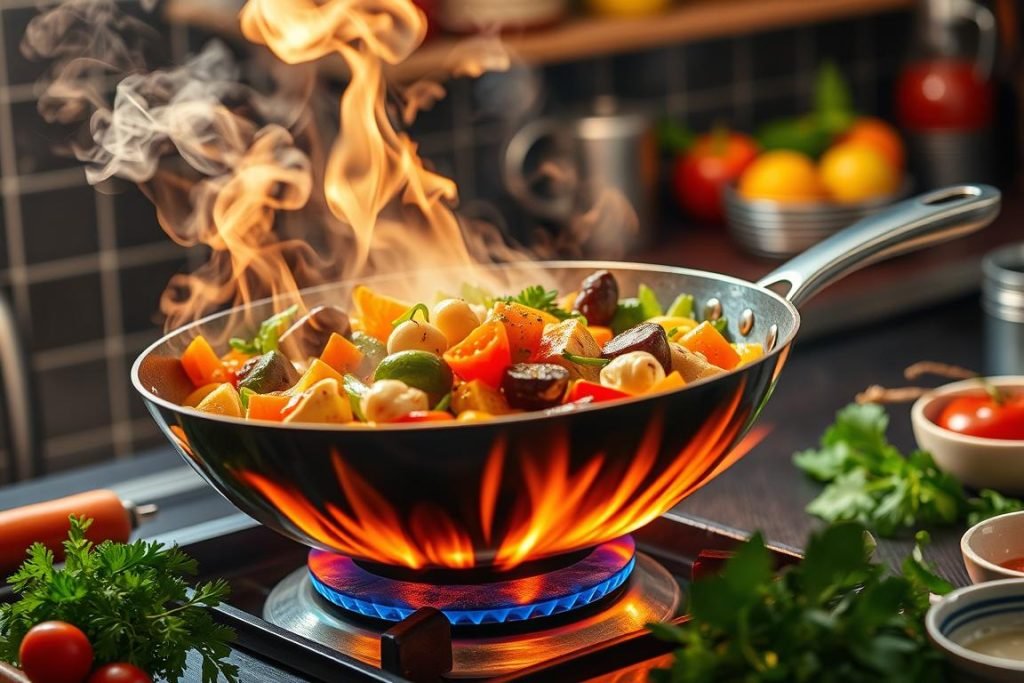
8: Ignoring the Browning Effect
Ever wondered about the secret to a perfectly browned dish? It’s all about pan searing and high-heat cooking. There’s a special moment known as the Maillard reaction. It happens when proteins and sugars mix, giving your food a delicious crust. Yet, many home cooks skip this step. They miss out on adding rich, complex flavors to their meals. Let’s look at why overlooking the browning effect is a loss. And we’ll see how it can totally change your cooking game.

Getting that brown sear is crucial. It’s not just about looks. It means your sauté is done right, locking in moisture and flavor. But, if you flip your food too early or don’t heat it enough, you end up with a bland taste. The secret? Have the patience to let a crust form. Remember, being patient is key to great cooking.
Key Takeaways
- Learn the Maillard reaction’s science for flavor in high-heat cooking.
- Avoid flipping too soon. Wait for the right time to form a good crust with pan searing.
- Use the right temperature for effective browning and avoid mushy dishes.
- Use consistent methods to boost your culinary skills and make flavorful meals.
- See how cooking methods, temperatures, and seasoning affect your sautéd dishes.
Mistake
One big mistake when cooking is not knowing the smoke point of oils used for high-heat cooking. Picking the right oil can make a big difference in your food’s taste. Extra virgin olive oil burns quickly because it has a low smoke point. This can make your food taste bitter and less nutritious.
For better cooking, use oils like avocado, grapeseed, or refined canola oil. These oils can handle high heat without burning. This keeps your food safe and tasty. Using the right oil is a key tip for anyone who loves to cook.
Using the correct oil improves taste and makes your dishes healthier. Here’s how to choose the best oil for sautéing:
- Look at the oil’s smoke point on its label.
- Choose refined oils for cooking at high temperatures.
- Save low smoke point oils like extra virgin olive oil for dressings and low-heat cooking.
| Oil Type | Smoke Point | Best Use |
|---|---|---|
| Extra Virgin Olive Oil | 375°F (190°C) | Dressings, marinades |
| Avocado Oil | 520°F (271°C) | Sautéing, frying |
| Grapeseed Oil | 420°F (216°C) | Baking, sautéing |
| Refined Canola Oil | 400°F (204°C) | General cooking, stir-frying |
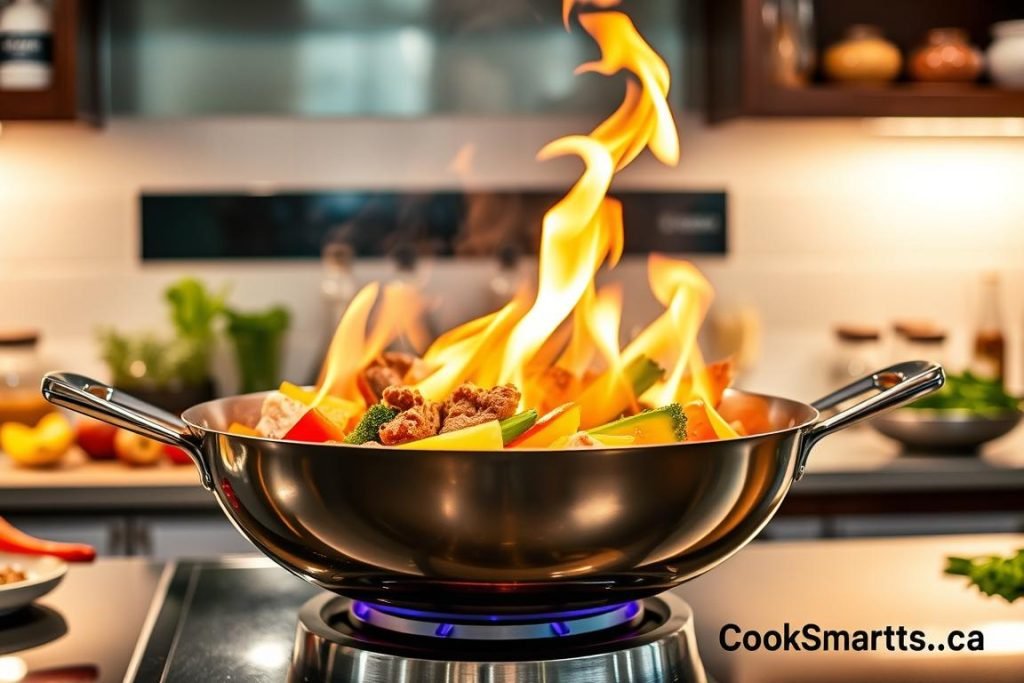
Adding these refined oils to your cooking can lift your meals to the next level. Mastering high-heat cooking means knowing your tools and ingredients well. This includes choosing the right oils for a winning recipe.
When you start cooking, you might think the secret to perfect sautéing is using fancy ingredients or tricky methods. But, what if the real trick is paying attention to the simple things? With everyone wanting quick meals on weeknights, learning to sauté well is key. However, even skilled cooks can mess up. They overlook small things that greatly affect the dish’s taste and texture.
Key Takeaways
- Ensure to use about four quarts of water per pound of pasta for al dente perfection.
- For golden and non-greasy fried foods, heat your oil to at least 350 degrees Fahrenheit.
- Choose oils like canola or grape seed with high smoke points for a successful sauté.
- Understand that fresh herbs like parsley and basil pack more punch than their dried counterparts.
- Avoid overcooking meat by familiarizing yourself with proper cooking times and temperatures.
- Always remember to preheat your pan to encapsulate juices and achieve a beautiful sear.
- For stir-frying, use a wok or a sizeable stainless steel skillet to avoid overcrowding.
Mistake
A big mistake home cooks often make is not heating the pan enough before they start cooking. This can cause food to cook wrongly or taste bland.
Understanding how heat works in cooking can improve your sautéing. The Leidenfrost Effect happens at about 379°F. It shows the right time to add oil. You’ll see water dance on the pan when it’s hot enough.
But the right heat for oil is near 425°F. Get this by warming your pan on medium-high for 5 minutes.
Here’s a table of common errors with heat and their effects:
| Mistake | Frequency | Impact on Dish |
|---|---|---|
| Food isn’t browning properly | 1 out of 15 | Lack of desired texture and depth of flavor |
| Not achieving a good sear on meat | 1 out of 15 | Inadequate caramelization, affecting both taste and presentation |
| Under-cooking a roast | 1 out of 15 | Uneven cooking and potential health risks |
Make sure you heat your pan well to avoid these issues. This improves your food’s taste and quality. So heat your pan right before you sauté. Enjoy your cooking!
Sautéing is praised worldwide in culinary schools and kitchens for its fast and flavorful results. But, have you thought about its effects on the veggies’ nutrition? When you think of colorful stir-fries and fragrant sautéd onions, do you consider their nutritional value too?
While we often favor convenience and taste, this might cost us vital nutrients. Finding the right mix of keeping the food’s nutritional worth and getting the desired taste is key. This balance is essential for not just a great meal, but also a healthier diet.
Key Takeaways
- The high-heat of sautéing may impact the water-soluble vitamins in vegetables such as vitamin C and certain B vitamins.
- Steaming has its pitfalls too; overdoing it can sap flavor, prompting the addition of high-calorie sauces.
- Frying sacrifices antioxidants and good fats for unwanted calories, while air frying could be a vitamin-saving alternative.
- Excessive amounts of sodium and fatty dressings can transform healthy dishes into hidden calorie reservoirs – moderation is key.
- Choosing the right oil is as important as the cooking method; avoid saturated fats in favor of options like olive or avocado oil for heart health.
- Preheating your pan and evenly chopping your ingredients are non-negotiable for achieving the perfect sauté.
Mistake
Getting your dishes to taste just right involves more than following recipes. It’s key to know how to fix flavors that don’t turn out as expected. This guide helps with five common taste problems: too salty, too sour, too bitter, too sweet, and too spicy.
For each flavor issue, there are ways to make it right, so your cooking efforts shine. Whether it’s too salty or too bitter, you can fix it. Finding the right solution brings your dish back to a tasty balance.
- Too Salty: Add unsalted liquid, broth, or more ingredients like vegetables or grains to lessen the saltiness.
- Too Sour: To reduce sourness, mix in honey, sugar, or caramelized onions. They add a deep sweetness.
- Too Bitter: Combat bitterness with fat and sugar. Try cream, butter, or a bit of sugar.
- Too Sweet: Cut the sweetness by adding lemon juice or vinegar. Or, try a pinch of salt.
- Overly Spicy: Dairy like yogurt or cream cools down spice. Or, use sugar or nut butter to tame it.
Knowing how to fix these issues not only saves your dish but also boosts your cooking skills. Read on for a table that shows how to correct these flavor problems:
| Flavor Issue | Common Causes | Solutions | Example Ingredients |
|---|---|---|---|
| Too Salty | Adding too much seasoning, using processed items | More ingredients (liquids, veggies) | Water, potatoes, rice |
| Too Sour | Too much vinegar or citrus | Add something sweet | Sugar, honey, cream |
| Too Bitter | Burnt parts, certain veggies | Add fats or sweets | Cream, butter, sugar |
| Too Sweet | Using too much sugar or sweet stuff | Add acid or salt | Lemon, vinegar, salt |
| Overly Spicy | Excess pepper or hot peppers | Try dairy or sweet things | Yogurt, sugar, nut butter |
These tips help you not only save your meal but also improve the overall eating experience. They prove your ability to adapt and excel in cooking.
Imagine making every ingredient in your kitchen amazing. Think about it: the way you cook might be keeping you from great flavors. You pick the best food and get everything ready. But sometimes, the dish doesn’t show off the flavors you hoped for. Could a mistake in your cooking steps be the reason?
Key Takeaways
- Not paying enough attention to sautéing can make your meals taste and feel off.
- To get that perfect sear and texture, the pan’s heat and drying ingredients before cooking are key.
- Using advanced freezing for fish can keep it fresher than old methods. This shows that fresh isn’t always top choice.
- Meat should be at room temperature, rested properly, and cooked with the right oils for the best result.
- Getting the measurements right, seasoning well, and watching the cook time are crucial for a good dish.
Mistake
Sautéing needs careful attention to the oil used and the heat. This method can boost food flavors when done right. Yet, many cooks mess up by not balancing the oil and heat well. This mistake can ruin a dish.
Choosing oil with the right smoke point is key. High smoke point oils like refined canola (400°F) or peanut oil (440°F) work best. They stop the oil from breaking down and keep your food tasting great.
| Fat Type | Smoke Point | Recommended Use |
|---|---|---|
| Extra Virgin Olive Oil | 320°F | Light sauté, low-heat applications |
| Butter | 350°F | Short sauté, flavor-rich dishes |
| Canola Oil | 400°F | General sautéing |
| Peanut Oil | 440°F | High-heat sautéing |
Getting the right heat is also crucial. Heat your pan before adding oil to make sure it’s ready for cooking. About 4 minutes is usually enough to preheat a pan properly.
Keep the food moving in the pan to cook everything evenly. Sautéing is fast but needs your full attention. Change the heat as needed for the oil and food type.
Mixing butter and oil, like canola, is a smart move. It combines flavor with the ability to cook at high temperatures without burning.
Knowing how to match oils and heat lets you sauté perfectly. This skill helps avoid common mistakes and boosts your cooking game. Master this, and your dishes will always impress.
Getting the hang of sautéing might seem tricky. It’s key for both seasoned cooks and beginners to master this skill. It opens up a world of flavors. Yet, often there’s a simple, crucial step that’s missed. Even though it’s a basic skill learned early in culinary school, many make mistakes. Especially when using high-quality olive oils approved for high cooking.
Vegetable, canola, grapeseed, avocado, and coconut oils are great because they handle high heat well. Cutting everything the same size means it all cooks evenly. However, not heating your pan enough can ruin your dish. So, pay attention to the fats you use, their smoke points, and your pan’s material. This makes the difference between just OK meals and amazing ones.
This guide dives into common mistakes even careful cooks might overlook. By April 22, 2023, we’ve collected expert advice and tips to sharpen your sautéing. We aim to help you reach perfection in your cooking.
Key Takeaways
- Identify the best oils for sautéing, with an eye on their smoke points, to ensure your dishes are flawlessly cooked—not burnt.
- Discover why preheating your pan can make or break the sautéing process and how 4 minutes could be the golden timeframe.
- Learn the importance of selecting the right sauté pan, made of either stainless steel, cast iron, or aluminum, for even heat distribution.
- Understand the pivotal temperature for proteins to begin browning, unlocking deep flavors in your cooking.
- Realize why overcrowding is the adversary of desirable browning and how cooking in batches can elevate your dishes.
- Acknowledge the role of seasoning and movement in the pan for achieving the elusive perfection in the art of sautéing.
- Embrace the mixture of butter and oil for their respective flavor and heat tolerance, elevating the taste profile of your creations.
Mistake
Mastering sautéing is like learning an art. It makes simple ingredients taste amazing. Knowing how to avoid common mistakes is important. This method uses a hot pan with a little oil to cook small, tender pieces of food. But, mistakes like choosing the wrong pan or oil, or using too much or too little heat, can ruin the dish.
It’s key to use the right pan for sautéing. A good sauté pan has a heavy bottom and angled sides for even heat. Use oils like soy, canola, or avocado. They don’t burn easily, unlike butter. Also, don’t crowd the pan. Cook ingredients in batches to avoid steaming them. Seasoning during cooking and keeping the food moving helps cook everything evenly and makes it tasty.
Start with a hot pan and oil. This way, foods cook right away and won’t stick. Knowing which oil to use is important. For example, peanut oil can handle the heat without burning. Sometimes, a mix of oil and butter adds flavor without burning the food. Learning to sauté well is fundamental. Use evenly cut, dry ingredients for the best results. Understanding each choice, from the pan to when to season, is what makes sautéing an art.